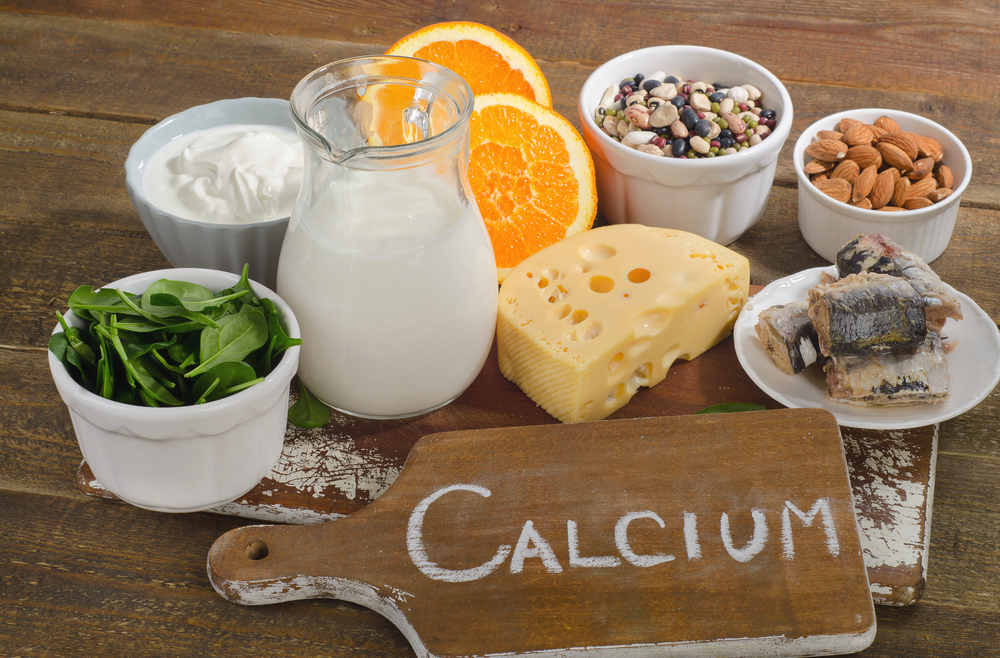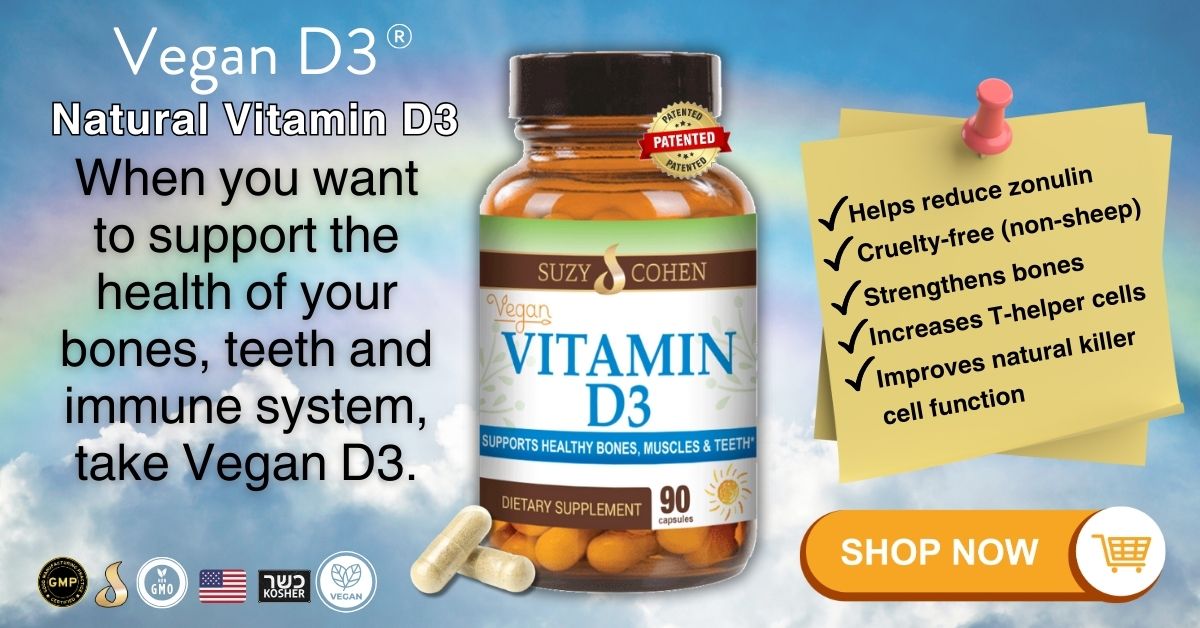What's On This Page?
ToggleVitamin D is good for more than preventing Rickets. It helps offset the lack of sunshine during the winter, cold months when depression or melancholy sets in, and immune cells get sluggish. Low levels makes every autoimmune condition worse. Use my search box to learn more about your condition because I’ve written about it many times.
When physicians talk about vitamin D deficiency, they are invariably talking about low levels of a compound called hydroxyvitamin D 25 or “25 (OH) Vitamin D3” which is inactive. There’s another form in case you didn’t realize it, it’s the “1,25 (OH)” form which is biologically active.
Our kidney has the lovely task of converting D from inactive 25 form, to the active 1,25 form, and magnesium is necessary for that conversion. Drug muggers that steal magnesium (such as acid blockers, diuretics and steroids) can hinder the conversion process. Additionally, kidney disease or reduced kidney function means suppressed D activity and thus, reduced 1,25 levels of the active form.
As much as I love D, toxicity can occur if you take very high doses of vitamin D because it uses up your magnesium stores, leading to low levels of magnesium and relatively higher calcium. The picture of this mineral see-saw can trigger heart palpitations, nausea, constipation, kidney stones, memory loss, softening of bones, hyperparathyroidism and body aches.
Today I’ll teach you something new about vitamin D testing.
As mentioned earlier, most physicians measure your blood levels of D 25 (which is the inactive form). Keep in mind your cells have receptors on them for vitamin D to attach too. Picture a lock and key where the key is “D” and the lock is the receptor on your cell.
The inactive form of D (25) grabs hold of this D receptor (VDR) and occupies it kind of like a key sitting in the lock (but you can’t turn it). In my example the 25 D renders the receptor inactive. Darn! Now your cell can’t bind the 1,25 form of D which is what you want!
All the receptors are occupied with inactive D, rather than active 1,25 form. But docs are measuring the inactive form to get a picture of D levels and I’m saying that you could have sufficient levels of inactive D, and poor conversion which would lead to insufficiency (even in the face of “normal” 25 D levels). If your doctor evaluates your inactive form and makes the assumption you are converting properly and you have all the nutrients on board to convert, that is a rather big assumption.
I don’t advise you supplement based upon low 25 D levels (unfortunately, this is seen on almost all lab tests) because that is only half the picture.
There are two reasons you should want to measure your D correctly and get two different levels.
- Complete Health Picture: The inactive form (25(OH)D) shows how much vitamin D is stored in your body, but it doesn’t tell you about its effectiveness or usability by your body’s tissues. The active form (1,25(OH)2D) is the form that the body actually uses to carry out important functions like calcium absorption and immune regulation. Measuring both forms provides a fuller picture of how well your body is processing and using vitamin D.
- Accurate Diagnosis and Treatment: By measuring both forms, doctors can better diagnose and treat various health conditions. For instance, if the inactive form is high but the active form is low, it might indicate issues with the kidneys (which convert inactive to active vitamin D) or with nutrient deficiencies like magnesium which are necessary for this conversion. This information is crucial for accurately adjusting vitamin D supplementation and managing overall health effectively.

Evaluate BOTH Biomarkers
It’s better to evaluate two biomarkers in one blood test (just measure BOTH of these):
1,25 (OH) Vitamin D3: Active
25 (OH) Vitamin D3: Inactive
Your doctor can evaluate both biomarkers and see how much active versus inactive D you have.
The optimal ratio of the inactive to the active form of vitamin D in the blood isn’t commonly discussed in clinical settings, primarily because these two forms of vitamin D serve different functions and are influenced by different physiological processes.
1. 25-Hydroxyvitamin D (25(OH)D): This is the inactive form of vitamin D, and it is the most commonly measured in blood tests because it is a good indicator of vitamin D exposure and storage in the body. The normal range for 25(OH)D in the blood is typically considered to be between 20 to 50 ng/mL, although some studies suggest maintaining levels closer to 30-50 ng/mL for optimal health.
2. 1,25-Dihydroxyvitamin D (1,25(OH)2D): This is the active form of vitamin D. Its levels are often not measured routinely in clinical practice because they can be normal even when there is a vitamin D deficiency, due to its regulation by other factors like parathyroid hormone (PTH), calcium, and phosphate levels. The normal range for 1,25(OH)2D is generally between 20 to 65 pg/mL.
Because the regulation of these two forms is so different, and the active form (1,25(OH)2D) is tightly controlled by the body and does not fluctuate in the same way as the inactive form (25(OH)D), there is no standard “ratio” used clinically between these two measures. Instead, the absolute values of each form are considered in the context of each other along with additional clinical information.
For a comprehensive assessment, it’s important to measure the inactive form to assess vitamin D status and consider measuring the active form when there is a reason to suspect altered metabolism, such as in patients with kidney disease, hyperparathyroidism, or granulomatous diseases like sarcoidosis, where the enzyme that converts the inactive to the active form may be overactive.
Low levels of 1,25 (active) D can occur with kidney disease since the kidneys are unable to activate the inactive 25 form to 1,25 which is active. You would think a high amount of the 1,25 form is desirable but it’s not. It could spell parathyroid disease, sarcoidosis, rheumatoid, fibromyalgia, Lyme and many other infections.
You physician can determine how much D you need, and how much you should supplement with. If you enjoyed my article on vitamin D, here are other articles I have written: ‘Vitamin D helps from Head toToe‘ and Vitamin D Helps with Asthma‘
Should You Supplement Based on Low 25 D?
Personally, I wouldn’t supplement based solely upon low levels of the 25 D. It’s inactive. It’s what you see on most labs today. The reason is because your active 1,25 levels might be fine, or even high. Keep in mind that just because you take supplements, doesn’t necessarily mean you activate that D either!
I think you should get the full picture and evaluate both forms of D. It’s scary that over 100 drugs impact your D and calcium levels. You can read more about nutrient depletions in my Drug Muggers book.
“D” Conversion and Health Risks
Understanding the intricate balance of Vitamin D metabolism is crucial for effective supplementation and prevention of associated health risks. It’s not just about having adequate Vitamin D levels; it’s about ensuring these levels are effectively converted in the body, especially from the inactive to the active forms. As I’ve mentioned, magnesium is essential for this conversion process.
However, many commonly used medications—such as acid blockers and diuretics—are notorious for depleting magnesium, which can severely impede this crucial metabolic step.
Over-Supplementation Risks
While vitamin D is vital for health, more isn’t always better. Excessive intake can cause hypercalcemia, leading to issues like kidney stones or vascular calcification. Current guidelines recommend keeping daily vitamin D intake below 4,000 IU for most adults unless under professional supervision. It’s crucial to balance vitamin D with cofactors like magnesium and vitamin K2, which help regulate calcium and enhance vitamin D’s benefits. Regular blood tests are essential to ensure you’re within safe and effective ranges.
Too Much Can Be Toxic
While Vitamin D is celebrated for its benefits, excessive intake can lead to toxicity. Symptoms of toxicity often mimic those of magnesium deficiency, including muscle weakness, nausea, and an imbalance in calcium levels, which can lead to more severe complications like kidney stones and cardiovascular issues. Again, I’d like to emphasize the part about regular blood testing.
This dual nature of Vitamin D—both as a necessity and a potential hazard—emphasizes the need for a balanced approach to supplementation, considering not only the dosage but also the individual’s medication profile and overall mineral balance.
I mentioned calcium. There are subtle nuances with that mineral too. I know a lot about calcium having dealt with hyperparathyroidism. You can read more about calcium in my article, Calcium and Hypercalcemia Treatment Options.
Strategic Supplementation: Beyond the Numbers
When it comes to supplementing, it’s essential to move beyond the numbers seen on standard lab reports and consider a more holistic view of health. For those considering Vitamin D supplementation, it’s crucial to ensure that both the active and inactive forms are measured, to get a clear picture of how well your body is utilizing the Vitamin D you ingest.
This comprehensive approach helps tailor supplementation to individual needs, preventing the common pitfalls of over-supplementation and ensuring that all necessary co-factors, like magnesium, are present in adequate amounts.

Moreover, given that over 100 different drugs can affect your Vitamin D and calcium levels, those on medication should take extra precautions. Ensure your supplement is bioavailable, and ideally, in a form that is easily absorbed by the body and easy to swallow. This approach not only supports better health outcomes but also aligns with a more personalized medicine approach, where supplementation is tailored to the unique health profiles and needs of individuals.
By integrating these considerations into your health regimen, you can better manage your Vitamin D levels, enhance overall health, and mitigate the risks associated with improper supplementation.
Summary
There are important reasons why vitamin D testing should be more thorough and I hope this blog has enlightened you. Let me summarize it here for you:
- Detection of Different Forms of Vitamin D: Testing typically measures the level of 25-hydroxyvitamin D (25(OH)D), which is an inactive precursor form.
However, understanding both the inactive 25(OH)D and the active 1,25-dihydroxyvitamin D (1,25(OH)2D) forms is crucial. The active form is responsible for many of vitamin D’s biological effects, including calcium regulation and immune function. Testing only the inactive form may provide incomplete information about an individual’s vitamin D status, particularly their ability to convert the inactive form to its active counterpart due to factors like kidney health or magnesium levels, namely low levels.
The second reason is pretty obvious. More detailed testing allows for better management of supplementation and avoids potential health issues by taking too much, or too little.
- Identification of Potential Toxicity or Deficiency: Comprehensive vitamin D testing can help avoid both deficiency and toxicity. A thorough understanding of both active and inactive vitamin D levels helps to tailor supplementation more accurately.
- Testing Active vs. Inactive Vitamin D: While measuring 25(OH)D levels is the gold standard for assessing vitamin D status, checking 1,25(OH)2D levels is typically reserved by doctors for specific situations in people – they don’t blanket test you. It’s reserved usually for people with issues such as kidney disease, granulomatous disorders like sarcoidosis, or unexplained calcium imbalances. In otherwise healthy individuals, active vitamin D levels can appear normal even when the inactive form is low, potentially leading to misleading conclusions. So keep that in your back pocket.
This is important because excessive intake of D supplements can lead to high levels of calcium in the blood, causing symptoms such as nausea, weakness, and frequent urination, and more severe consequences like kidney damage. Conversely, not detecting a deficiency might lead to bone health issues and compromised immune function.

Suzy Cohen, has been a licensed pharmacist for over 30 years and believes the best approach to chronic illness is a combination of natural medicine and conventional. She founded her own dietary supplement company specializing in custom-formulas, some of which have patents. With a special focus on functional medicine, thyroid health and drug nutrient depletion, Suzy is the author of several related books including Thyroid Healthy, Drug Muggers, Diabetes Without Drugs, and a nationally syndicated column.



